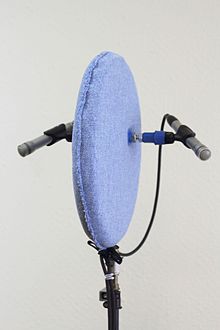Jecklin disk
The Jecklin disk is a device for making stereo recordings. It is one of the separator microphone systems and uses two or four microphones. The method is characterized by the fact that with comparatively little technical effort - with good acoustic conditions - natural sounding recordings can be made. The process goes back to the Swiss radio sound engineer Jürg Jecklin , who named his invention " OSS disk" (Optimum Stereo Signal).
construction
An OSS or Jecklin structure consists of a disc coated with sound-absorbing material and measuring 30 cm in diameter . This disk is arranged as a partition, i.e. as a separating body , between two microphones with omnidirectional characteristics. The microphone base between the two microphone capsules is 16.5 cm - a value assumed to be the mean distance between the ears of an adult (2 × 8.25 cm = 16.5 cm), which corresponds to a transit time difference Δ t of a maximum of 0.48 ms. The quasi “ ear signals ” of both microphones are recorded on a separate sound track; see also binaural sound recording .
Working principle
A structure with a Jecklin disc generates a stereo signal in which the directional information is represented both by time differences and by frequency-dependent sound pressure level differences. The arrangement of the two microphones positioned 16.5 cm apart creates the head-like running time differences that occur in nature through head shadowing. The Jecklin disk itself causes, by shading sound waves arriving from the side, clearly frequency-dependent level differences Δ L , which increase towards the high frequencies and decrease sharply towards the low frequencies, i.e. are purely mono below 500 Hz . These particular signal differences are called spectral differences .
Characteristic properties of a recording with a Jecklin disk
When using a jecklin disk and microphones with omnidirectional sound coloration can be expected from comb filter effects, but they are not very conspicuous generally at lateral sound incidence.
Due to the tendency of low-frequency sound - stronger than high-frequency sound - to be bent around objects in the propagation path, the level differences between the left and right signals are different for different frequencies . In the case of laterally incident sound with a decreasing frequency, the level difference left / right drops below a cut-off frequency of 500 Hz when using a Jecklin disc with a diameter of 30 cm, so that in practical operation the level of the left-right signals in the bass range is the same . The signals below 500 Hz are to be regarded as mono.
Modification of the disc
An enlarged disc diameter of now 35 cm, instead of 30 cm, and the more than doubled microphone base , i.e. the distance between the omnidirectional microphones from now 36 cm instead of 16.5 cm, which was supposed to simulate the ear distance , should improve the sound recording.
With this arrangement, the sound advantages of the omnidirectional microphones come into their own. The correct, angle-dependent travel time differences of the sound result from the distance between the two microphones, the level differences and spectral differences from the acoustic separation of the pane. The two microphones must have a linear diffuse field frequency response .
Among the advantages of the inventor of Jecklin OSS system called (Optimum stereo system) are a good bass response to the drawbacks of a sharp and aggressive sounding recording with sound side.
literature
- Michael Dickreiter, Volker Dittel, Wolfgang Hoeg, Martin Wöhr: Manual of the recording studio technology . 8th edition. De Gruyter Saur, Berlin 2013, ISBN 978-3-11-028978-7 (1511 pages, in 2 volumes).
Individual evidence
- ^ Michael Dickreiter: Handbook of studio technology. Saur, Munich 1987, ISBN 3-598-10588-6 , Vol. 1, p. 328.
- ↑ Jürg Jecklin: Microphones, page 32 at the bottom - The latest Jecklin record - PDF
- ↑ Oliver Curdt, Separator Microphone Systems , University of the Media, Stuttgart, 2010
See also
Binaural sound recording | Runtime stereophony | Ear gap | Separator | Omnidirectional microphone |
